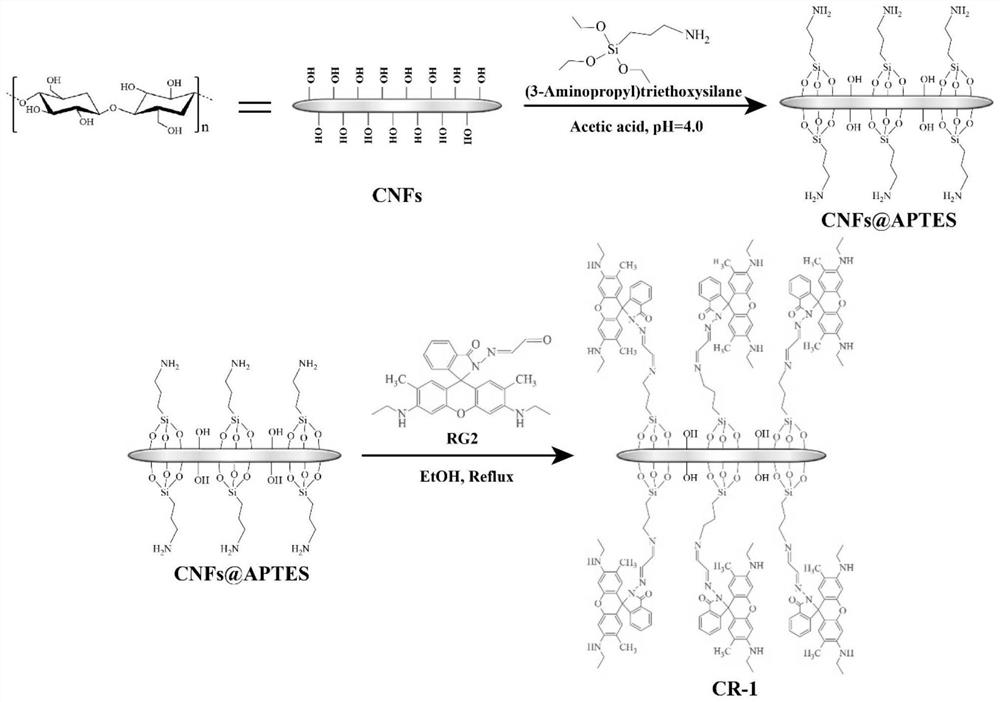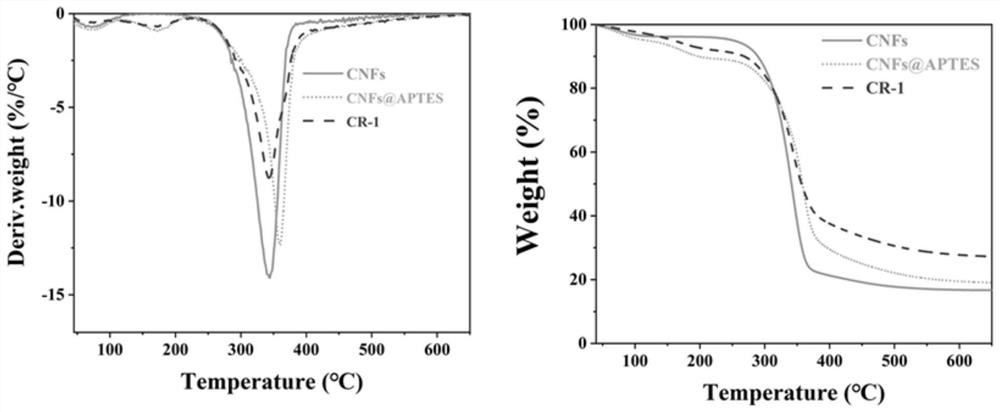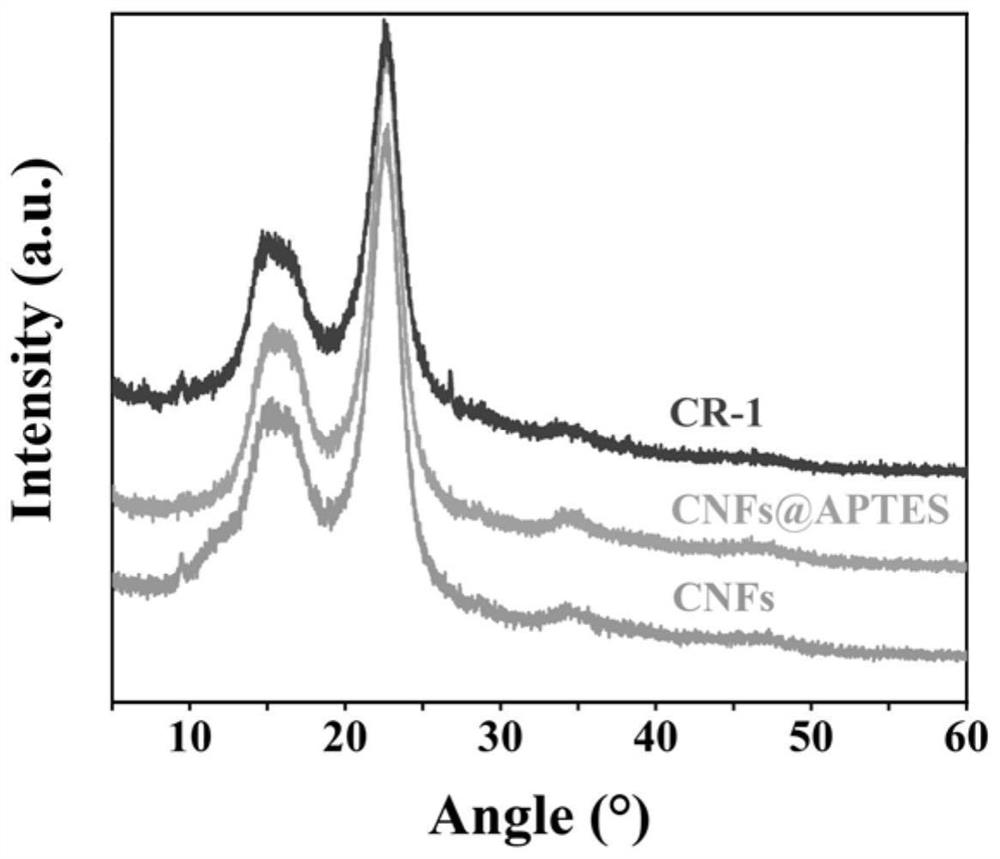A nano-cellulose-based fluorescent material responsive to iron ions and its preparation method and application
A technology of nanocellulose and fluorescent materials, applied in the field of fluorescent detection nanofunctional materials, can solve the problems of difficult processing and molding of fluorescent small molecules, uniform distribution of difficult fluorescent molecules, poor stability of fluorescent probes, etc., and achieve the specific surface area of ultrafine structure. , degradability, good selectivity
- Summary
- Abstract
- Description
- Claims
- Application Information
AI Technical Summary
Problems solved by technology
Method used
Image
Examples
Embodiment 1
[0044] (1) First, dissolve 2 mmol of Rhodamine 6G in 30 mL of absolute ethanol, add 2.2 mmol of hydrazine hydrate (80%) dropwise at room temperature and keep stirring, after adding, the resulting mixture is reacted at 65° C. under vigorous stirring for 2 h; the solvent was removed under reduced pressure, the product was washed 3 times with ethanol / aqueous solution (1:1, v / v), and dried to obtain a pink solid RG1;
[0045] (2) 1 mmol RG1 was dissolved in 10 mL of absolute ethanol, 2 mmol of glyoxal (40%) was added, and the resulting mixture was stirred at room temperature for 12 hours; the precipitate produced by filtration was washed 3 times with absolute ethanol and dried. Then get yellow solid RG2;
[0046] (3) 5 mL of 3-aminopropyl-triethoxysilane (APTES) was slowly added to 100 mL of ethanol / water (20 / 80, v / v) solution under magnetic stirring, and the pH was adjusted with glacial acetic acid. When the pH was stable at 4, 1 g of nanocellulose (specifically, cellulose nanofib...
Embodiment 2
[0056] (1) Take the nanocellulose-based fluorescent material prepared in Example 1 and configure it into a suspension of 0.002 g / mL;
[0057] (2) The configuration concentration is 10 -3 Fe of M 3+ Standard solutions and concentrations of 10 -3 M's Al 3+ , Cu 2+ , Cr 3+ and other metal cations (Other ions) (including Ni 2+ , Zn 2+ , Ca 2+ , Ba 2+ , Mg 2+ , Hg 2+ , Pb 2+ , Co 2+ , Mn 2+ , K + , Na + , Li + ) solution, ready for use;
[0058] (3) Take two milliliters of the suspension in the step (1) in different quartz cuvettes that are transparent on all sides, then add the various metal cation solutions in the step (2) respectively, and detect it with an ultraviolet spectrophotometer. Absorption spectrum at 400nm-650nm; use a fluorescence spectrometer to detect the fluorescence intensity, the slit of the fluorescence spectrometer is set to 5nm, the excitation wavelength is set to 500nm, and the fluorescence intensity of the emission peak at the wavelength of ...
Embodiment 3
[0061] (1) Take the nanocellulose-based fluorescent material prepared in Example 1 and configure it into a suspension of 0.002 g / mL;
[0062] (2) The configuration concentration is 10 -3 Fe of M 3+ Standard solution, spare;
[0063] (3) Take two milliliters of the suspension in step (1) in different quartz cuvettes that are transparent on all sides, and then add a series of Fe of different dilution ratios in step (2) respectively. 3+ Solution, use a fluorescence spectrometer to detect the fluorescence intensity, the slit of the fluorescence spectrometer is set to 5nm, the excitation wavelength is set to 500nm, and the fluorescence intensity of the emission peak at the wavelength of 556nm is detected.
[0064] The result is as Figure 7 As shown, within the range of 1 μM to 10 μM, with the increase of iron ion content, the phenomenon of fluorescence intensity enhancement at 556 nm becomes more and more obvious, and the fluorescence intensity (F-F 0 ) / F 0 Good linearity wit...
PUM
 Login to View More
Login to View More Abstract
Description
Claims
Application Information
 Login to View More
Login to View More - R&D
- Intellectual Property
- Life Sciences
- Materials
- Tech Scout
- Unparalleled Data Quality
- Higher Quality Content
- 60% Fewer Hallucinations
Browse by: Latest US Patents, China's latest patents, Technical Efficacy Thesaurus, Application Domain, Technology Topic, Popular Technical Reports.
© 2025 PatSnap. All rights reserved.Legal|Privacy policy|Modern Slavery Act Transparency Statement|Sitemap|About US| Contact US: help@patsnap.com



